英语语言学知识点整理
- 格式:doc
- 大小:125.50 KB
- 文档页数:7
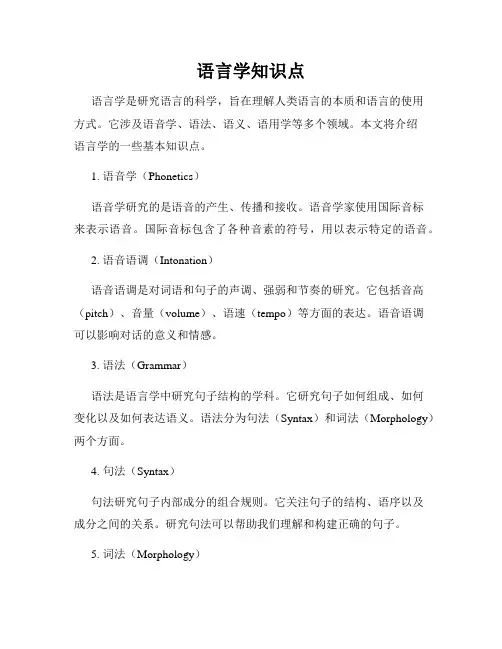
语言学知识点语言学是研究语言的科学,旨在理解人类语言的本质和语言的使用方式。
它涉及语音学、语法、语义、语用学等多个领域。
本文将介绍语言学的一些基本知识点。
1. 语音学(Phonetics)语音学研究的是语音的产生、传播和接收。
语音学家使用国际音标来表示语音。
国际音标包含了各种音素的符号,用以表示特定的语音。
2. 语音语调(Intonation)语音语调是对词语和句子的声调、强弱和节奏的研究。
它包括音高(pitch)、音量(volume)、语速(tempo)等方面的表达。
语音语调可以影响对话的意义和情感。
3. 语法(Grammar)语法是语言学中研究句子结构的学科。
它研究句子如何组成、如何变化以及如何表达语义。
语法分为句法(Syntax)和词法(Morphology)两个方面。
4. 句法(Syntax)句法研究句子内部成分的组合规则。
它关注句子的结构、语序以及成分之间的关系。
研究句法可以帮助我们理解和构建正确的句子。
5. 词法(Morphology)词法研究词的内部结构和变化规律。
它关注单词的构成要素(词根、词缀等)以及单词形态的变化。
6. 语义学(Semantics)语义学是研究词义和句义的学科。
它关注语言符号与现实世界之间的关系,研究词语和句子的意义。
语义学可以帮助我们理解语言的意义和表达的方式。
7. 语用学(Pragmatics)语用学研究语言在具体语境中的使用和解释。
它关注的是说话人的意图、听者的理解以及背后的非字面意义。
语用学帮助我们理解语言的社交功能和交际规则。
8. 语言变体(Language Variation)语言变体指的是同一语言在不同社会群体之间产生的差异。
这些差异可以体现在发音、词汇、语法以及语用等方面。
语言变体是语言学中一个重要的研究领域。
9. 二语习得(Second Language Acquisition)二语习得研究的是学习第二语言的过程和条件。
它包括语言输入、语言输出和语言环境对第二语言学习的影响等方面。
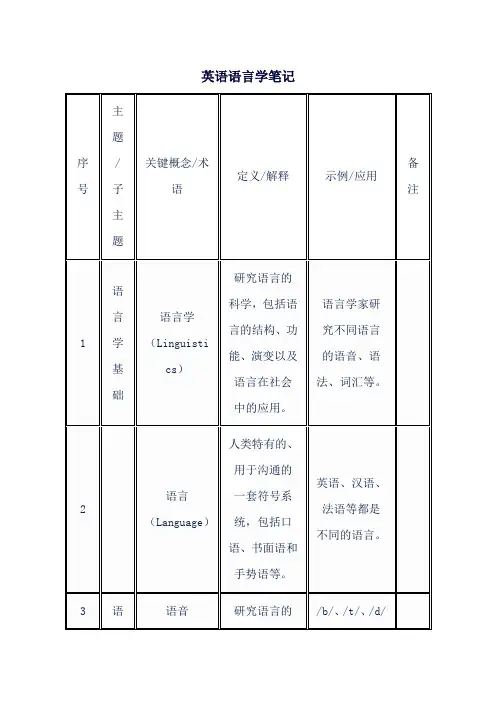
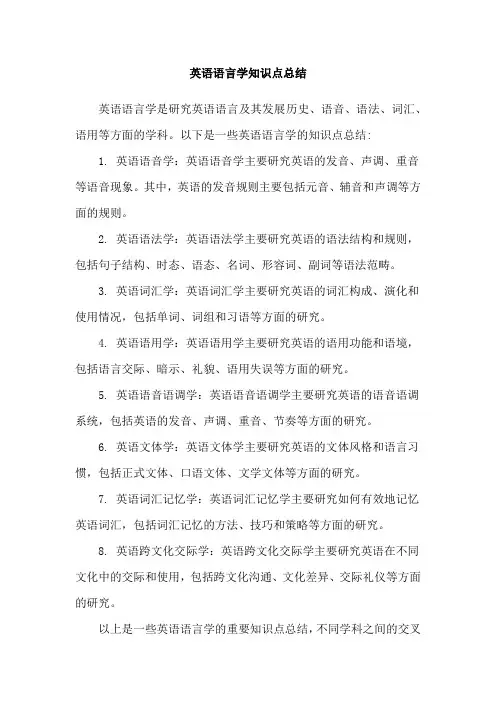
英语语言学知识点总结
英语语言学是研究英语语言及其发展历史、语音、语法、词汇、语用等方面的学科。
以下是一些英语语言学的知识点总结:
1. 英语语音学:英语语音学主要研究英语的发音、声调、重音等语音现象。
其中,英语的发音规则主要包括元音、辅音和声调等方面的规则。
2. 英语语法学:英语语法学主要研究英语的语法结构和规则,包括句子结构、时态、语态、名词、形容词、副词等语法范畴。
3. 英语词汇学:英语词汇学主要研究英语的词汇构成、演化和使用情况,包括单词、词组和习语等方面的研究。
4. 英语语用学:英语语用学主要研究英语的语用功能和语境,包括语言交际、暗示、礼貌、语用失误等方面的研究。
5. 英语语音语调学:英语语音语调学主要研究英语的语音语调系统,包括英语的发音、声调、重音、节奏等方面的研究。
6. 英语文体学:英语文体学主要研究英语的文体风格和语言习惯,包括正式文体、口语文体、文学文体等方面的研究。
7. 英语词汇记忆学:英语词汇记忆学主要研究如何有效地记忆英语词汇,包括词汇记忆的方法、技巧和策略等方面的研究。
8. 英语跨文化交际学:英语跨文化交际学主要研究英语在不同文化中的交际和使用,包括跨文化沟通、文化差异、交际礼仪等方面的研究。
以上是一些英语语言学的重要知识点总结,不同学科之间的交叉
和融合也在不断推进着英语语言学的发展。
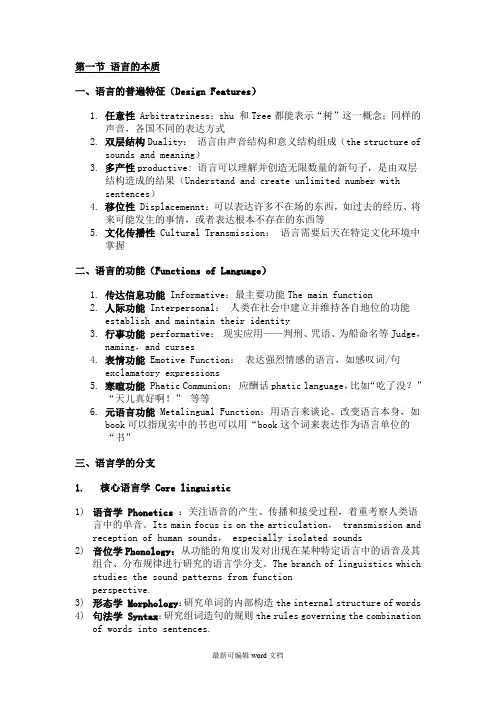
第一节语言的本质一、语言的普遍特征(Design Features)1.任意性 Arbitratriness:shu 和Tree都能表示“树”这一概念;同样的声音,各国不同的表达方式2.双层结构Duality:语言由声音结构和意义结构组成(the structure ofsounds and meaning)3.多产性productive: 语言可以理解并创造无限数量的新句子,是由双层结构造成的结果(Understand and create unlimited number withsentences)4.移位性 Displacemennt:可以表达许多不在场的东西,如过去的经历、将来可能发生的事情,或者表达根本不存在的东西等5.文化传播性 Cultural Transmission:语言需要后天在特定文化环境中掌握二、语言的功能(Functions of Language)1.传达信息功能 Informative:最主要功能The main function2.人际功能 Interpersonal:人类在社会中建立并维持各自地位的功能establish and maintain their identity3.行事功能 performative:现实应用——判刑、咒语、为船命名等Judge,naming,and curses4.表情功能 Emotive Function:表达强烈情感的语言,如感叹词/句exclamatory expressions5.寒暄功能 Phatic Communion:应酬话phatic language,比如“吃了没?”“天儿真好啊!”等等6.元语言功能 Metalingual Function:用语言来谈论、改变语言本身,如book可以指现实中的书也可以用“book这个词来表达作为语言单位的“书”三、语言学的分支1. 核心语言学 Core linguistic1)语音学 Phonetics:关注语音的产生、传播和接受过程,着重考察人类语言中的单音。
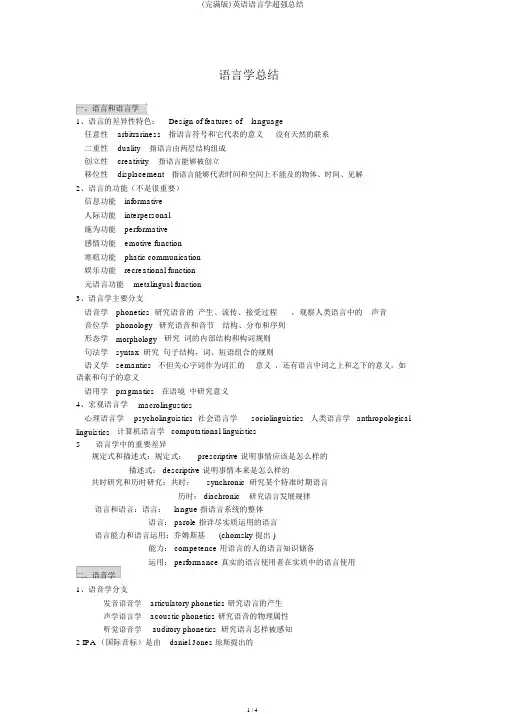
语言学总结一、语言和语言学1、语言的差异性特色:Design of features of language任意性arbitrariness指语言符号和它代表的意义没有天然的联系二重性duality指语言由两层结构组成创立性creativity指语言能够被创立移位性displacement指语言能够代表时间和空间上不能及的物体、时间、见解2、语言的功能(不是很重要)信息功能informative人际功能interpersonal施为功能performative感情功能emotive function寒暄功能phatic communication娱乐功能recreational function元语言功能metalingual function3、语言学主要分支语音学phonetics 研究语音的产生、流传、接受过程,观察人类语言中的声音音位学phonology研究语音和音节结构、分布和序列形态学morphology研究词的内部结构和构词规则句法学syntax 研究句子结构,词、短语组合的规则语义学semantics不但关心字词作为词汇的意义,还有语言中词之上和之下的意义。
如语素和句子的意义语用学pragmatics在语境中研究意义4、宏观语言学macrolingustics心理语言学psycholinguistics 社会语言学sociolinguistics 人类语言学 anthropological linguistics计算机语言学 computational linguistics5语言学中的重要差异规定式和描述式:规定式:prescriptive 说明事情应该是怎么样的描述式: descriptive 说明事情本来是怎么样的共时研究和历时研究:共时:synchronic 研究某个特准时期语言历时: diachronic研究语言发展规律语言和语言:语言:langue 指语言系统的整体语言: parole 指详尽实质运用的语言语言能力和语言运用:乔姆斯基(chomsky 提出 )能力: competence 用语言的人的语言知识储备运用: performance 真实的语言使用者在实质中的语言使用二、语音学1、语音学分支发音语音学声学语言学听觉语音学articulatory phonetics 研究语言的产生acoustic phonetics 研究语音的物理属性auditory phonetics 研究语言怎样被感知2 IPA (国际音标)是由daniel Jones 琼斯提出的三、音位学1、最小对峙体minimal pairs2、音位phoneme3音位变体allophones4互补分布 complementary distribution5自由变体 free variation6差异特色 distinctive features7超音段特色 suprasegmental feature音节syllable 重音 stress 语调 tone 声调 intonation四形态学1词的组成语素 morpheme 自由语素 free morpheme 粘着语素bound morphemeRoot 词根词缀affix词干stem屈折词汇和派生词汇inflectional affix and derivational affix2特有的词汇变化 lexical change proper新创词语 invention 混拼词 blending 缩写词 abbreviation首字母缩写词 acronym逆构词汇 back-formation 例: editor— edit类推构词 analogiacal creation 例: work-worked,,slay-slayed外来词 borrowing五句法学1范围 category 数 number性 gender 格 case 时 tense 体 aspect一致关系 concord支配关系 govenrment2结构主义学派 the structure approach组合关系syntagmatic relation 词和词组合在一起聚合关系paradigmatic 拥有共同的语法作用的词聚在一起结构和成分construction and constituents : 句子不但是线性结构liner structure 还是层级结构hierarchical structure(句子或短语被称为结构体,而组成句子或短语即结构体的称为成分) 3直接成分解析法immediate constitutional analysis指把句子分成直接成分-短语,再把这些短语依次切分,获取下一集直接成分,这样层层切分,直到不能够再分4向心结构和离心结构 endocentric and exocentric constructions向心:指一个结构中有中心词,例an old man ,中心为 man离心:指结构中没有明显的中心词。
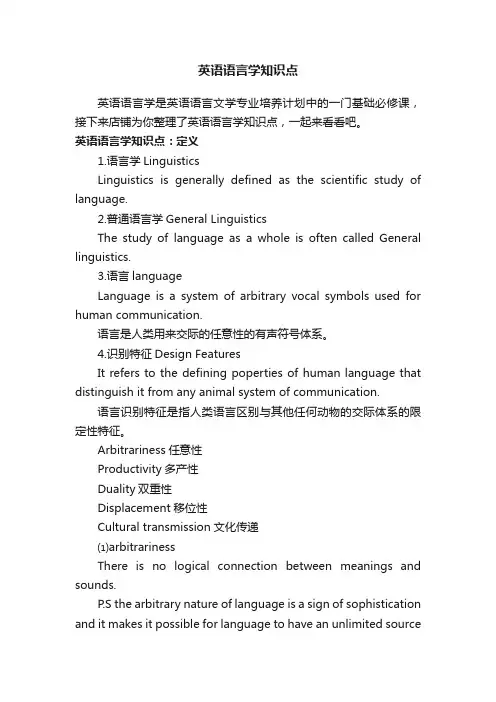
英语语言学知识点英语语言学是英语语言文学专业培养计划中的一门基础必修课,接下来店铺为你整理了英语语言学知识点,一起来看看吧。
英语语言学知识点:定义1.语言学LinguisticsLinguistics is generally defined as the scientific study of language.2.普通语言学General LinguisticsThe study of language as a whole is often called General linguistics.3.语言languageLanguage is a system of arbitrary vocal symbols used for human communication.语言是人类用来交际的任意性的有声符号体系。
4.识别特征Design FeaturesIt refers to the defining poperties of human language that distinguish it from any animal system of communication.语言识别特征是指人类语言区别与其他任何动物的交际体系的限定性特征。
Arbitrariness任意性Productivity多产性Duality双重性Displacement移位性Cultural transmission文化传递⑴arbitrarinessThere is no logical connection between meanings and sounds.P.S the arbitrary nature of language is a sign of sophistication and it makes it possible for language to have an unlimited sourceof expressions⑵ProductivityAnimals are quite limited in the messages they are able to send.⑶DualityLanguage is a system, which consists of two sets of structures ,or two levels.⑷DisplacementLanguage can be used to refer to contexts removed from the immediate situations of the speaker.⑸Cultural transmissionHuman capacity for language has a genetic basis, but we have to be taught and learned the details of any language system. this showed that language is culturally transmitted. not by instinct. animals are born with the capacity to produce the set of calls peculiar to their species.5.语言能力CompetenceCo mpetence is the ideal user’s knowledge of the rules of his language.6.语言运用performancePerformance is the actual realization of this knowledge in linguistic communication.语言运用是所掌握的规则在语言交际中的体现。
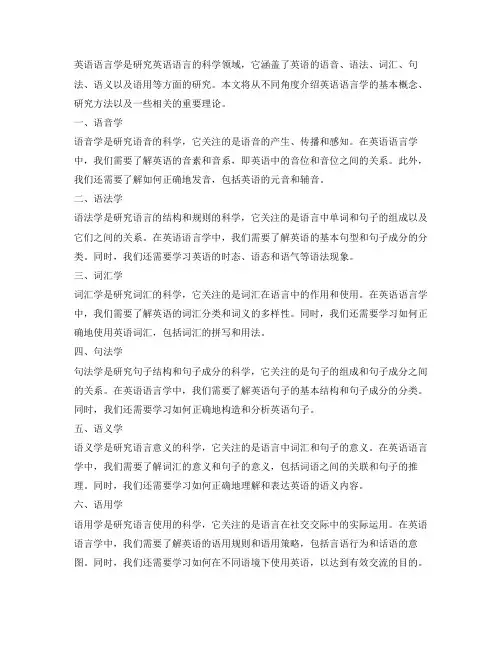
英语语言学是研究英语语言的科学领域,它涵盖了英语的语音、语法、词汇、句法、语义以及语用等方面的研究。
本文将从不同角度介绍英语语言学的基本概念、研究方法以及一些相关的重要理论。
一、语音学语音学是研究语音的科学,它关注的是语音的产生、传播和感知。
在英语语言学中,我们需要了解英语的音素和音系,即英语中的音位和音位之间的关系。
此外,我们还需要了解如何正确地发音,包括英语的元音和辅音。
二、语法学语法学是研究语言的结构和规则的科学,它关注的是语言中单词和句子的组成以及它们之间的关系。
在英语语言学中,我们需要了解英语的基本句型和句子成分的分类。
同时,我们还需要学习英语的时态、语态和语气等语法现象。
三、词汇学词汇学是研究词汇的科学,它关注的是词汇在语言中的作用和使用。
在英语语言学中,我们需要了解英语的词汇分类和词义的多样性。
同时,我们还需要学习如何正确地使用英语词汇,包括词汇的拼写和用法。
四、句法学句法学是研究句子结构和句子成分的科学,它关注的是句子的组成和句子成分之间的关系。
在英语语言学中,我们需要了解英语句子的基本结构和句子成分的分类。
同时,我们还需要学习如何正确地构造和分析英语句子。
五、语义学语义学是研究语言意义的科学,它关注的是语言中词汇和句子的意义。
在英语语言学中,我们需要了解词汇的意义和句子的意义,包括词语之间的关联和句子的推理。
同时,我们还需要学习如何正确地理解和表达英语的语义内容。
六、语用学语用学是研究语言使用的科学,它关注的是语言在社交交际中的实际运用。
在英语语言学中,我们需要了解英语的语用规则和语用策略,包括言语行为和话语的意图。
同时,我们还需要学习如何在不同语境下使用英语,以达到有效交流的目的。
《(827)英语语言学知识》是一篇关于英语语言学基本概念、研究方法和相关理论的文档。
通过学习语音学、语法学、词汇学、句法学、语义学和语用学等方面的知识,我们可以更好地理解和运用英语语言。
希望本文能够帮助读者对英语语言学有更深入的了解和认识。
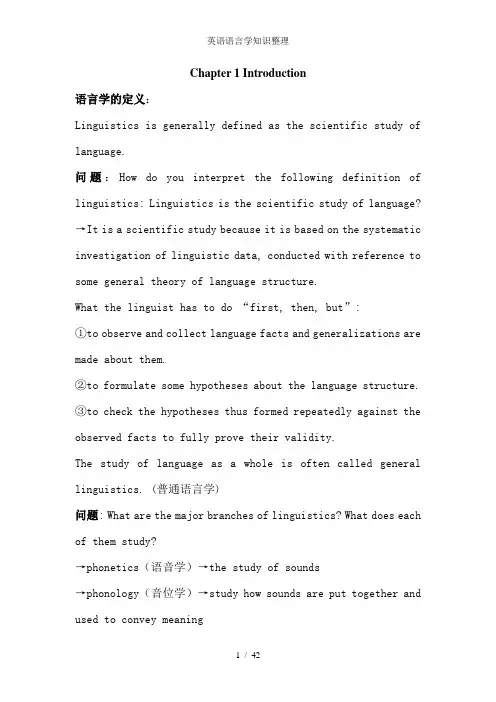
Chapter 1 Introduction语言学的定义:Linguistics is generally defined as the scientific study of language.问题:How do you interpret the following definition of linguistics: Linguistics is the scientific study of language?→It is a scientific study because it is based on the systematic investigation of linguistic data, conducted with reference to some general theory of language structure.What the linguist has to do “first, then, but”:①to observe and collect language facts and generalizations are made about them.②to formulate some hypotheses about the language structure.③to check the hypotheses thus formed repeatedly against the observed facts to fully prove their validity.The study of language as a whole is often called general linguistics. (普通语言学)问题: What are the major branches of linguistics? What does each of them study?→phonetics(语音学)→the study of sounds→phonology(音位学)→study how sounds are put together and used to convey meaning→morphology(形态学)→study the way in which symbols or morphemes are arranged and combined to form words.→syntax(句法学)→the study of rules of forming sentences →semantics(语义学)→the study of meaning→pragmatics(语用学)→ the context of language use Sociolinguistics(社会语言学):The studies of all these social aspects of language and its relation with society form the core of the branch.Psycholinguistics(语言心理学):Relate the study of language to psychologyApplied linguistics(应用语言学):In a narrow sense it refers to the application of linguistic theories and principles to language teaching, especially the teaching of foreign and second languages.Some important distinctions in linguistics:①prescriptive(规定性)/descriptive(描写性)②synchronic(共时)/diachronic(历时)③speech(口语)/writing(书面语)④langue(语言)/parole(言语)(the Swiss linguist F. de Saussure ——Course in General Linguistics)⑤competence(语言能力)/performance(语言应用)(the American linguist N. Chomsky)⑥traditional grammar (传统语法)/modern linguistics(现代语言学)问题:in what basic ways does modern linguistics differ from traditional grammar?①linguistics is descriptive while traditional grammar is prescriptive.②modern linguistics regards the spoken language as primary, not the written.③modern linguistics does not force languages into a Latin-based framework.问题:Is modern linguistics mainly synchronic or diachronic? Why?In modern linguistics, a synchronic (不考虑历史演进的, 限于一时的) approach seems to enjoy priority over a diachronic (探求现象变化的, 历时的) one.Because it is believed that unless the various states of a language in different historical periods are successfully studied, it would be difficult to describe the changes that have taken place in its historical development.Synchronic descriptions are often thought of as being descriptions of language in its current existence, and most linguistic studies are of this type.问题:For what reasons does modern linguistics give priority to speech rather than to writing?From the point of view of linguistic evolution, speech is prior to writing. The writing system of any language is always “invented”by its users to record speech when the need arises. Even in today’s world there are still many languages that can only be spoken but not written. Then in everyday communication, speech plays a greater role than writing in terms of the amount of information conveyed.Spoken language reveals more true features of human speech while written language is only the “revised”record of speech. And linguists’data for investigation and analysis are mostly drawn from everyday speech, which they regarded as authentic.语言的定义:Language is a system of arbitrary vocal symbols used for human communication.Design features of language(7个识别特征)①arbitrariness 任意性(at the syntactic level)②productivity 能产性,创造性Secondary units(底层结构 sounds)③duality 双层性Primary units (上层结构 units of meaning)④displacement 不受时空限制性(handle generalization and abstraction)⑤cultural transmission 文化传递性⑥interchangeability 互换性⑦convention 约定性Functions of language:三大主要功能:The descriptive functionThe expressive functionThe social functionRoman Jacobson(6种首要因素,结构主义语言学家)①speaker addresser→emotive 感情功能②addressee→conative 意动功能③context→referential所指功能④message→poetic 诗学功能⑤contact→phatic communion交感功能⑥code→metalinguistic 元语言功能Other functions:①phatic function 问候功能②informative f. 信息功能③interrogative f. 询问功能④expressive f. 表达功能⑤evocative f. 感染功能⑥directive f. 指令功能⑦performative f. 行使(权力)功能M.A.K. Halliday①ideational②interpersonal(indicate/establish/maintain/social relationships)③textual问题:How is Saussure’s distinction between langue and parole similar to Chomsky’s distinction between competence and performance?The distinction between langue and parole was made by Saussure, langue is abstract; it is not the language people actually use. Parole is concrete; it refers to the naturally occurring language events. Langue is relatively stable; it does not change frequently, while parole varies from people to people, and from situation to situation.The distinction between competence and performance proposed by the American linguists Chomsky, competence is a deal user’s knowledge of the rules of his language, and the performance is the actual realization of this knowledge in linguisticcommunication. Imperfect performance is caused by social and psychological factors.Saussure makes this distinction in order to single out one aspect of language for serious study. In his opinion, parole is simple a mass of linguistic facts, too varied confusing for systematic investigation, and that linguistics should do is to abstract langue from parole, i.e., to discover the regularities governing the actual use of language and make them the subjects of study of linguistics.Similar to Saussure, Chomsky thinks what linguists should study is the ideal speaker’s competence, not his performance, which is too haphazard to be studied.问题:What are the main features of human language that have been specified by C. Hockett to show that it is essentially different from animal communication system?①arbitrariness 任意性(at the syntactic level)②productivity 能产性,创造性Secondary units(底层结构 sounds)③duality 双层性Primary units (上层结构 units of meaning)④displacement 不受时空限制性(handle generalization andabstraction)⑤cultural transmission 文化传递性⑥interchangeability 互换性⑦convention 约定性Chapter 2 PhonologyPhonetics: (语音学)①the study of the phonic medium of language②look at speech sounds from 3 distinct but related points of view.Ⅰstudy the sounds from the speaker’s point of view→articulatory phonetics(发音语音学)Ⅱlook at the sounds from the hearer’s point of view→auditory phonetics(听觉语音学)Ⅲstudy the way sounds travel by looking at the sound waves →acoustic phonetics(声学语音学)③study how sounds are produced, transmitted and perceived. Organs of speech:⒈three important areas①The pharyngeal cavity→the throat② the oral cavity→the mouth③ the nasal cavity→the nose⒉The pharyngeal cavity→windpipe/glottis/larynx/vocalcords⒊the oral cavity→tongue/uvula/soft palate(velum)/hard palate/teeth ridge(alveolus)/teeth/lipsInternational Phonetic Alphabet (IPA)①diacritics 附加符号②broad transcription(宽式标音)→the transcription with letter-symbols only③narrow transcription(严式标音)→the transcription withletter-symbols together withthe diacriticsClassification of English speech sounds①two broad categories of speech sounds in English: Vowels/consonants②two ways to classify the English consonants: In terms ofmanner ofarticulationIn terms of place of articulation③In terms of manner of articulation:Stops/fricatives/affricates/liquids/nasals/glides④In terms of place of articulation:Bilabial/labiodental/dental/alveolar/palatal/velar/glottal⑤Classification of English vowels⒈criteria :(monophthongs)单元音The position of the tongue in the mouth: front/central/back The openness of the mouth: close vowels/semi-closevowels/semi-openvowels/open vowels The shape of the lips: unrounded/roundedThe length of the vowels: tense/lax⒉diphthongs 双元音/ ei // ai // au // əu // ɔi // iə //εə// uə /Phonology 音韵学,语音体系Difference of phonology and phonetics:①Phonetics is interested in all the speech sounds used in allhuman languages.②Phonology aims to discover how speech sounds in a languageform patterns and how these sounds are used to convey meaning in linguistic communication.Phone(音素): A phone is a phonetic unit or segment. Phoneme(音位): It is a phonological unit; it is a unit that is of distinctive value. It is an abstract unit. It is not any particular sound, but rather it is represented or realized by a certain phone in a certain phonetic context.Allophone(音位变体): The different phones which can represent a phoneme in different phonetic environments are called the allophones of that phoneme.Phonemic contrast(音位对立)Complementary distribution(音位变体的互补分布)Minimal pairs(最小对立体):含音位的单词的全部音标Minimal set(最小对立集):is used to find the important sounds in language.Phonological Analysis(音位分析)Principle: certain sounds cause changes in the meaning of a word or phase, whereas other sounds do not.Phonetically similar sounds:描述音位关系Free variants: 音位的自由变体The difference of pronouncing a sound caused by dialect, habit, individual difference or regional differences instead of by any distribution rule.Some rules in phonology①sequential rules: 序列规则If a word begins with a / l / or a / r /, then the next sound must be a vowel.If three consonants should cluster together at the beginning of a word, the combination should obey the following three rules:The first phoneme must be / s /The second phoneme must be / p / / t / / k /The third phoneme must be / l // r // w /②assimilation rule:同化规则③deletion rule:省略规则Suprasegmental features 超音段特征≠超音段(比音位更大的语言单位)①stress(单词,句子层面):the location of stress in English distinguishes meaning.Syllable音节:A syllable nucleus (often a vowel) with optional initial and final margins (often consonants)单音节词多音节词英语单词都有重读音位学中,单词由音节构成,音节由音位构成。
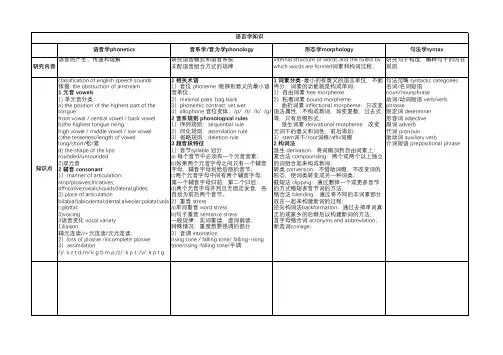
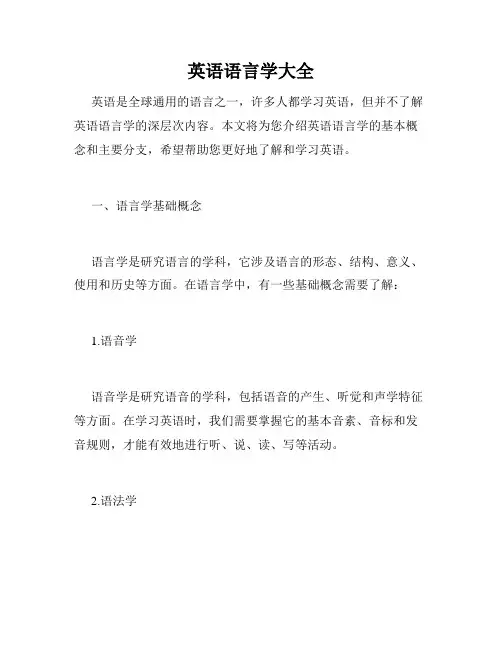
英语语言学大全英语是全球通用的语言之一,许多人都学习英语,但并不了解英语语言学的深层次内容。
本文将为您介绍英语语言学的基本概念和主要分支,希望帮助您更好地了解和学习英语。
一、语言学基础概念语言学是研究语言的学科,它涉及语言的形态、结构、意义、使用和历史等方面。
在语言学中,有一些基础概念需要了解:1.语音学语音学是研究语音的学科,包括语音的产生、听觉和声学特征等方面。
在学习英语时,我们需要掌握它的基本音素、音标和发音规则,才能有效地进行听、说、读、写等活动。
2.语法学语法学是研究语言结构和组织的学科,有时也称为句法学。
它研究语言的词类、句子结构、语法关系等方面。
通过学习英语的语法,我们可以正确使用语言,避免出现语法错误。
3.语义学语义学是研究语言意义的学科,它探究词汇、短语和句子意义的形成和变化。
在英语学习中,我们需要理解单词和短语的意义,以及句子的含义,以便正确理解和表达内容。
4.语用学语用学是研究语言使用的学科,包括口语和书面语言的使用场合、对话方式、说话人的语言目标和对听者的影响等方面。
在英语学习中,我们需要了解不同场合和对象的语言使用规范,以便与人交流时更加得心应手。
二、英语语言学的主要分支除了以上基础概念外,英语语言学还有一些重要的学术分支,能够帮助我们更深入地了解和掌握英语。
1.语音学英语语音学探究的是英语中的音素、音标和发音规则等方面,以及与其他语音系统的比较和差异。
2.语法学英语语法学研究的是英语的句法结构、语法关系和句子意义等方面,以及与其他语言的比较和翻译问题。
3.词汇学英语词汇学是研究英语词汇的学科,包括单词的来源、组成和意义等方面,以及与其他语言的比较和词汇翻译问题。
4.语用学英语语用学研究的是英语在语言使用中的实际应用,包括语言交际、言语行为、语境和语言目的等方面。
5.文本语言学英语文本语言学是研究英语文本的结构、组织和语言特点等方面的学科,包括语篇分析和修辞分析等内容。
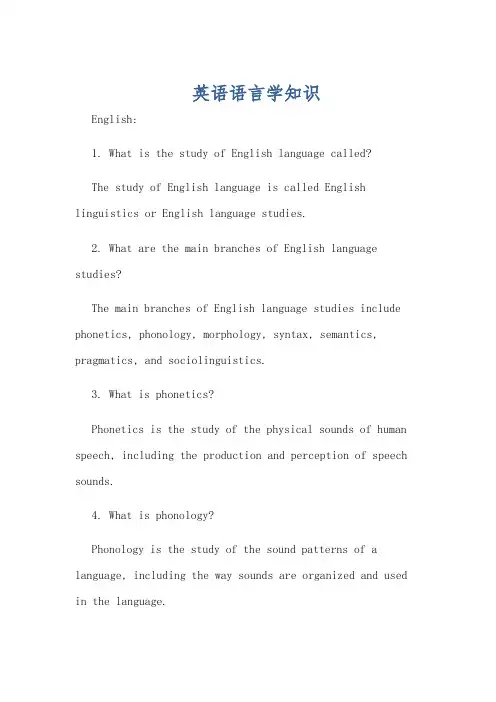
英语语言学知识English:1. What is the study of English language called?The study of English language is called English linguistics or English language studies.2. What are the main branches of English language studies?The main branches of English language studies include phonetics, phonology, morphology, syntax, semantics, pragmatics, and sociolinguistics.3. What is phonetics?Phonetics is the study of the physical sounds of human speech, including the production and perception of speech sounds.4. What is phonology?Phonology is the study of the sound patterns of a language, including the way sounds are organized and used in the language.5. What is morphology?Morphology is the study of the structure and formationof words in a language, including the ways in which words are formed and the relationships between different forms ofa word.6. What is syntax?Syntax is the study of the structure and formation of sentences in a language, including the rules and principles that govern how words are combined to form grammatical sentences.7. What is semantics?Semantics is the study of the meaning of words, phrases, and sentences in a language, including how meaning is constructed and interpreted in communication.8. What is pragmatics?Pragmatics is the study of the use of language in context, including how language is used to convey meaning and achieve communicative goals in different social and cultural settings.9. What is sociolinguistics?Sociolinguistics is the study of the relationship between language and society, including how language varies and changes in different social and cultural contexts.10. What are the major theories of language acquisition?The major theories of language acquisition include behaviorist theories, nativist theories, interactionist theories, and cognitive theories.中文:1. 英语语言学的研究叫什么?英语语言学的研究叫做英语语言学或英语语言研究。
第一单元What is linguistics? 什么是语言学?Linguistics is generally defined as the scientific study of language. It studies not any particular language, but languages in general.The scope of linguistics 语言学研究的范畴Phonetics语音学\Phonology音系学\Morphology形态学\Syntax句法学\Semantics语义学\Pragmatics语用学\Sociolinguistics社会语言学\Psycholinguistics心理语言学\Applied linguistics应用语言学Phonetics语音学:the study of sounds used in linguistic communication led to the establishment of a branch of linguistics called phoneticsPhonology音系学:as linguists became interested in how sounds put together and used to convey meaning in communication ,they developed another branch of study related to sounds called phonology.Morphology形态学:the study of the way in which these symbols are arranged form words has constituted the branch of study called morphology.Syntax句法学:the combination of these words to form permissible sentences in languages is governed by rules ,the study of these rules constitutes a major branch of linguistics studies Semantics语义学:the study of meaning was gradually developed and became known as semanticsPragmatics语用学:when the study of meaning is conducted,not in isolaion,but in the context of use,it becomes another branch of linguistic study called pragmaticsSociolinguistics社会语言学:the study of all these social aspects of language and its relation with society form the core of the branch called sociolinguisticsPsycholinguistics心理语言学: Psycholinguistics relates the study of language to psychology\Applied linguistics应用语言学:findings in linguistic studies can often be applied to the solution of such practical problems as the recovery of speech ability.the study of such applications is generally known as applied linguisticsOther related branchs include anthropological linguistics,neurological linguistics,mathematical linguistics,and computational linguistics.Some important distinctions in linguistics。
语言学Linguistic各章重点,学习资料整理1.1What is language?Language is a system of arbitrary vocal symbols used for human communication.1.2Design features of language①Arbitrariness任意性:The property of language by which there is in general no natural (i。
e。
logical)relation between the form of a single lexical unit and its meaning。
②Duality二重性Language consists of two levels of structures. The lower (secondary)level is a definite set of meaningless sounds, which combine to form meaningful units which constitute a higher (primary) level。
③Creativity创造性Language is creative in the sense that its users can understand and produce sentences they have never heard before。
④Displacement移位性By displacement is meant that language can be used to refer to things that are not present (in time and space)at the moment of communication。
1.3Functions of language①Informative信息功能Language serves an informative function when it is used to express the speaker’s opinion, to state a fact,or to reason things out。
第一章Invitation to Linguistics1.Definition of language:Language is a system of vocal (and written) symbols with meaning attached that is used forhuman communication of thoughts and feelings.2.Design features of language(语言的普遍特征):①.Arbitrariness 任意性:The forms of linguistic signs generally bear no natural relationship to the meanings they carry②.Duality 二重性:Human language has two levels of structures: the primary meaningful level of morphemes, words, phrases, sentences and the secondary meaningless level of sounds. The units of the primary level are composed of elements of the secondary level, and each of the two levels has its own principles of organization.③.Creativity 创造性:Language is resourceful because of its duality and recursiveness.④.Displacement移位性:Human languages enable their users to symbolize objects, events and concepts which are not present in time and space at the moment of communication.3.Functions of language1)Informative function2)Interpersonal function人际功能3)Performative (行为) function4)Emotive function5)Phatic (寒暄) function6)Recreational function7)Metalingual function(元语言功能)指用语言去说明或解释语言的功能4.Main branches of linguistics:Main branches of linguistics (microlinguistics微观) and interdisciplinary(跨领域、跨学科)fields of linguistics (macrolinguistics宏观)1) Main branches of linguistics:(1) Phonetics发音学,语音学;(2) Phonology;(音位学、语音体系)(3) Morphology 词法/ Lexicology词汇学;(4) Syntax句法;(5) Semantics语义学(6) Pragmatics语用学:研究特定情境中的特定话语,在不同的语言交际环境中如何理解和运用语言支。
★Haliday—child language. Macrofunctions: ideational, interpersonal, textual.★what are major branches of linguistics? what does each study?Phonetics----the study of the phonic medium of language, it’s concerned with all the sounds that occur in the world’s languages.Phonology---the study of sounds systems—the inventory of distinctive sounds that occur in a language and the patterns into which they fall.Morphology---It’s a branch of a grammar which studies the internal structure of words and the rules by which words are formed.Syntax-------it's a subfield of linguistics that studies the sentence structure of a language. Semantics---It’s simply defined as the study of meaning in abstraction.Pragmatics---the study of meaning in context of words. The study of how speakers of a language use sentences to effect successful communication.Sociolinguistics—the study of language with reference to society.Psycholinguistics---the study of language with reference to the working of the mind. Applied linguistics---the application of linguistic principles and theories to language teaching and learning.Chapter2 Phonology★three branches of phonetics:①Articulatory —describes the way our speech organs work to produce the speech sounds and how they differ. ②Auditory-–studies the physical properties of speech sounds, reaches the important conclusion that phonetic identity is only a theoretical ideal. ③Acoustic-–studies the physical properties of speech sounds ,the way sound travel from the speaker to the hearer.★Organs of Speech : Pharyngeal cavity–咽腔Oral cavity–口腔greatest source of modification of air stream found here Nasal cavity–鼻腔★Broad transcription: The transcription of speech sounds with letter symbols only. (leaf /l/) ★Narrow transcription: The transcription of speech sound with letters symbols and the diacritics.(dark /l/~)★Phonetics and Phonology区别: are concerned with the same aspect of language- the speech sounds. ①Phonetics: it is interested in all the speech sounds used in all human languages; phonetic features they possess; how they can be classified, etc. ②Phonology: it aims to discover how speech sounds in a language form patterns and how these sounds are used to convey meaning in linguistic communication.★rules in Phonology:①Sequential rules: Rules that govern the combination of sounds in a particular language. ②Assimilation rules: The assimilation rule assimilates one sound to another by’ copying ’a feature of a sequential phoneme, thus making the two phones similar.③Deletion rule: It’s a phonological rule which tells us when a sound is to be deleted although its orthographically represented.★Suprasegmental超切分特征: The phonemic features that occur above the level of the segment are called suprasegmental features. the main suprasegmental features include stress ,intonation and tone.(intonation: when pitch, stress and sound lenth are tied to the sentence rather than the word in isolation. //tone: Tone are pitch variations, which are caused by the differing rates of vibration of the vocal cords. Tone is a suprasegmental feature.)Chapter3 Morphology★open class words: new words can be added to these classes regularly. Such as nouns, verbs,adjectives and adverbs. Such as Beatnik. Closed class words:conjunctions, prepositions, articles and pronouns consist of the grammatical or functional words. The number of such words is small and stable since few new words are added.Chapter4 Syntax★determine a word’s category:①meaning. Word categories often bear some relationship with its meaning. The meaning associated with nouns and verbs can be elaborated in various ways. The property or attribute of the entities denoted by nouns can be elaborated by adjectives.(pretty lady, attribute the property “pretty”to the lady.) ②inflection. Words of different categories take different inflections. Such nouns as boy and desk take the plural affix -s. Verbs such as work and help take past tense affix -ed and progressive affix -ing. ③distribution. That is what type of elements can co-occur with a certain word. For example, the girl and a card ④小结A word's distributional facts together with information about its meaning and inflectional capabilities help identify its syntactic category.★phrase包括: head, specifier, complement. ①The word round which phrase is formed is termed head. ②The words on the left side of the heads are said to function as specifiers. Specifiers have both special semantic and syntactic roles: Semantically, they help make more precise the meaning of the head. Syntactically, they typically make a phrase boundary. ③The words on the right side of the heads are complements. Complements are themselves phrases and provide information about entities and locations whose existence is implied by the meaning of the head. They are attached to the right of the head in English.★phrase structure rule: The special type of grammatical mechanism that regulates the arrangement of elements that make up a phrase is called a phrase structure rule.★XP rule: In all phrases, the specifier is attached at the top level to the left of the head while the complement is attached to the right. These similarities can be summarized as an XP rule, in which X stands for the head N,V,A or P. (XP-----> (specifier) X (complement))★coordination rule:Some structures are formed by joining two or more elements of the same type with the help of a conjunction such as and or or. Such phenomenon is known as coordination. Such structure are called coordination structure. (Four important properties:①There is no limit on the number of coordinated categories that can appear prior to the conjunction. ②A category at any level (a head or an entire XP) can be coordinated. ③Coordinated categories must be of the same type. ④The category type of the coordinate phrase is identical to the category type of the elements being conjoined.) Coordination Rule: X------ > X *Con X)★deep structure and surface structure: There are two levels of syntactic structure. The first, formed by the XP rule in accordance with the head's subcategorization properties, is called deep structure (or D-structure). //The second, corresponding to the final syntactic form of the sentence which results from appropriate transformations, is called surface structure (or S-structure).Chapter 5 Semantics★The naming theory: (Greek scholar Plato) According to this theory, the linguistic forms or symbols, in other words, the words used in a language are taken to be labels of the objects they stand for, so words are just names or labels for things.★The conceptualist view: It holds that there is no direct link between a linguistic form and what it refers to; rather ,in the interpretation of meaning they are linked through themediation of concepts in the mind.★Contextualism: (J.R. Firth) people should be studied in terms of situation, use, context—elements closely linked with language behaviour. It’s based on the presumption that one can derive meaning from or reduce meaning to observable contexts. two kinds of context: the situational and the linguistic context. {A) the situational context: Every utterance occurs in a particular situation, the main components of which include, the speaker and the hearer, the actions they are performing, the various objects and events existent in the situation.-----The seal could not be found. B) the linguistic context: co-text, is concerned with the probability of a word’s co-occurrence or collocation with another word, which forms part of the “meaning” of the word, and also with the part of text that precedes and follows a particular utterance.-----black coffer& black hair.}★Sense refers to the inherent meaning of a linguistic form, which is the collection of all the features of the linguistic form, it’s abstract and de-contextualized. //Reference is what a linguistic form refers to in the real, physical world, it is a matter of relationship between the form and reality. //关系: ①Linguistic forms, having the same sense, may have different reference in different situations. ②Linguistic forms with the same reference may differ in sense.-----morning star= evening star. ③Linguistic forms may have sense, but have no reference in the real world.------dragon, ghost.★Hyponymy:It refers to the sense relation between a more general, more inclusive word and a more specific word. the word which is more general in meaning is called superordinate, and the more specific words are called its hyponyms.★X entails Y: entailment: the relationship between two sentences where the truth of one is inferred from the truth of the other. E.g. Cindy killed the dog entails the dog is dead. (X :John married a blond heiress. Y: John married a blond.)★componential analysis: an approach to analyze the lexical meaning into a set of meaning components or semantic features. For example, boy may be shown as [+human] [+male] [-adult]. semantic features:The smallest units of meaning in a word, which may be described as a combination of semantic components. For example, woman has the semantic features [+human] [-male] [+adult]. //Advantages: by specifying the semantic features of certain word, it will be possible to show how these words are related in meaning.★Predication Analysis:①The meaning of a sentence is not the sum total of the meanings of all its components, that is, the meaning of a sentence is not to be worked out by adding up all the meanings of its constituent words. E.g: The dog bit the man. & The man bit the dog.②There are two aspects to sentence meaning: grammatical meaning and semantic meaning. Grammaticality: grammatical (well-formedness); Semantically meaningful: selectional restrictions. (selectional restriction: Whether a sentence is semantically meaningful is governed by the rules called selectional restrictions, i.e. constraints on what lexical items can go with what others.)……(consist of predicate and argument)Chapter 6 pragmatics★Context(John Firth): The notion of context is essential to the pragmatic study of language, it’s generally considered as constituted by the knowledge shared by the speaker and the hearer. ★Speech act theory(John Austin)★Searle’s Classification of Speech Acts: 1 representatives: Stating or describing, saying what the speaker believes to be true. 2 directives: Trying to get the hearer to do something. 3commisives: Committing the speaker himself to some future course of action. 4 expressives: Expressing feelings or attitude towards an existing state. 5 declaration: Bring about immediate changes by saying something. ///Conclusion: All the acts that belong to the same category share the same purpose but differ in their strength or force.★cooperative Principle(CP): Proposed by Paul Grice, the principle that the participants must first of all be willing to cooperate in making conversation, otherwise, it would be impossible to carry on the talk.★Historical linguistics: a branch of linguistics, is mainly concerned with both the description and explanation of language changes that occurred over time.★semantic broadening: when the meaning of a word becomes broader, it may include all the meanings it used to mean, and then more. Such as holiday, which originally meant holy day, but it means any day which we don’t have to work.★semantic narrowing: semantic change has narrowed the meaning of some words. such as deer(any animal—a particular kind of animal)★semantic shif t: a lexical item may undergo a shift in meaning is the third kind of semantic change.★sociolinguistics: is the sub-field of linguistic that studies the relation between language and society, between the uses of language and the social structures in which the users of language live.★Inter-relationship between language and society:A) language is used not only to communicate meaning, but also establish and maintain social relationships. B) Users of the same language in a sense all speak differently, due to their social backgrounds. C) Language, especially the structure of its lexicon, reflects both the physical and the social environments of a society. E.g. there is only one word in English for snow, and there are several in Eskimo.D) Language is related to the structure if the society in which it is used, therefore, judgments concerning the correctness and purity of linguistic varieties are social rather than linguistic.E.g. the use of postvocalic [r] in England and in New Y ork city.★speech community: the social group that is singled out for any special study.★speech variety: refers to any distinguishable form of speech used by a speaker or a group of speakers. i.e. regional dialects, sociolects, registers★Register: in a restricted sense, refers to the variety of language related to one’s occupation. In a broader sense, the type of language which is selected as appropriate to the type of situation is a register. {A) Field of discourse---- topic: the purpose and subject matter of the communicative behavior.---- why/ what---vocabulary, phonological, grammatical features B) Tenor of discourse---- role: participants and in what relationship they stand to each other. ---- formality/ technicality of the language we use. C) Mode of discourse ---- means of communication.-----how ( speaking or writing).}★degree of formality: intimate; casual; consultative; formal; frozen★culture: A)In a broad sense: Culture means the total way of life of a people, including the patterns of belief, customs, objects, institutions, techniques, and language that characterizes the life of the human community. B) In a narrow sense: Culture may refer to a local or specific practice, beliefs or customs, which can be mostly found in folk culture, enterprise culture or food culture etc.★The relationship between language and culture:①language as an integral part of human being permeates his thinking and way of viewing the world. It both expresses and embodies cultural reality. ②reflects and affects a culture’s way of thinking and helps perpetuate and change the culture and its influence, which also facilitates the development of this language at the same time. ③language is a part of culture.★Sapir-Whorf Hypothesis: A belief that the way people view the world is determined wholly or partly by their structure of their native language.------interdependence of language and thought….(there are two interpretations: a strong version and a weak one. The strong version believes that language patterns determine people’s thinking and behavior. The weak one holds that the former influences the later.)★Greetings and terms of address:A) People in different countries choose the proper greetings to greet different people they meet on different occasions. B) The terms of address can be different in different countries. C) Chinese people will also extend kinship terms and indicate people’s influential st atus.★cultural overlap: The situation between two societies due to some similarities in the natural environment and psychology of human being★cultural diffusion: Through communication, some elements of culture A enter culture B and become part of culture B, thus bringing about cultural diffusion.★linguistics imperialism: it is a kind of kind of linguicism which can be defined as the promulgation of global ideologies through the world-wide expansion of one language.★language acquisition: It refers to the child’s acquisition of his mother tongue, i.e. how the child comes to understand and speak the language of his community. (the behaviourist, the innatist{ LAD= Language Acquisition Device}, the interactionist view{motherese, child directed speech, caretaker talk}★under-extension: Use a word with less than its usual range of denotation. E.g, baby uses animal to refer to cat, but denies the bird belongs to an animal.★over-extension:Extension of the meaning of a word beyond its usual domain of application by young children. E.g, baby uses apple for all fruit.★Atypical Development:hearing impairment, mental retardation, autism, stuttering, aphasia, dyslexia, dysgraphia.★second language acquisition: It refers to the systematic study of how one person acquires a second language subsequent to his native language.★Connection between first language acquisition and second language acquisition: ①Theoretically----The new findings and advances in fist language acquisition especially in learning theories and learning process are illuminating in understanding second language acquisition. ②Practically------The techniques used to collect and analyze data in first language acquisition also provide insights and perspectives in the study of second language acquisition. ③second language acquisition is different from first language acquisition and the second language learners generally fail to attain native-like competence. ★interlanguage: A type of language produced by second and foreign language learners, who are in the process of learning a language, and this type of language usually contains wrong expressions. It is also called learner language.-- its main feature is fossilization.★overgeneralization: The use of previously available strategies in new situations, in which they are unacceptable. E.g: Jane suggested me to give up smoking (×).★cross-association: some words are similar in meaning as well as spelling and pronunciation. This internal interference is called cross-association. E.g. The apricot is too sour to eat it(×). ★Individual Differences:①Language aptitude ②motivation(instrumental motivation; integrative motivation; resultative motivation; intrinsic motivation pleasure from learning.)③learning strategie (cognitive strategies; metacognitive strategies; affect/ social strategies)④Age of Acquisition. ⑤Personality★Neurolinguistics: is the study of language disorders and the relationship between the brain and language. It includes research into how the structure of the brain influences language learning, how and in which parts of the brain language is stored, and how damage to the brain affects the ability to use language.★Aphasia refers to a number of acquired language disorder due to the cerebral lesions caused by vascular problems, a tumor, an accident and so on.★psycholinguistics is the study of psychological states and mental activity associated with the use of language. It concerns the representation of language in the mind, the planning, production, perception and comprehension of speech, and language acquisition.front central backClose (high) i:I u:uSemi-close (middle)eз:。
英语课程中的语言学基础知识在英语学习过程中,了解语言学的基础知识是非常重要的。
本文将介绍一些英语课程中的语言学基础知识,帮助读者更好地理解和学习英语。
一、语言的定义和特征语言是人类最基本的交流工具,它具有以下几个特征:1. 可以传递信息:语言通过语音、文字等形式传递信息,使人们能够相互理解和沟通。
2. 组成规则性:语言具有一定的语法规则,包括词汇、句子结构等,通过这些规则组织语言的表达。
3. 具有音、义两个层面:语言既有音的层面,即语音学,也有词汇、句法等层面,即语义学。
4. 社会性:语言是社会群体的共同表征,不同社群有不同的语言系统。
二、语音学基础知识语音学研究的是语言的声音部分,包括音素、音节、音变等。
在英语学习中,掌握语音学的基础知识有助于正确发音和理解他人的语音信息。
1. 音素:音素是语言中的最小语音单位,可以区分词义。
英语中有约40个音素,包括元音和辅音。
2. 音节:音节是组成词的基本单位,它包括一个或多个音素。
英语中,音节由元音或元音组合的辅音开头,辅音结尾的形式组成。
3. 重音:重音在英语中具有很重要的作用,它通常落在词的某个音节上,加强了该音节的语音强度和音高。
三、语法学基础知识语法学是语言学中的重要分支,研究的是词汇、句法等语言结构的规则和规律。
掌握基本的语法知识对于理解和使用英语语法非常有帮助。
1. 词汇:词汇是语言中的基本单位,通过词汇可以组成不同的句子和表达。
英语中的词汇分为名词、动词、形容词等不同类别,并具有单复数、时态、语态等语法特征。
2. 句法:句法研究语言中句子的结构和成分之间的关系。
了解句法规则可以帮助我们正确组织句子和理解句子的意义。
3. 语法关系:在句子中,词语之间有很多不同的关系,比如主谓关系、动宾关系、定语从句等,了解这些语法关系对于正确理解句子结构和意义非常重要。
四、语义学基础知识语义学研究语言的意义和词语之间的关系。
在英语学习中,了解语义学基础知识可以帮助学习者更准确地理解和使用英语词汇。
★Haliday—child language. Macrofunctions: ideational, interpersonal, textual.★what are major branches of linguistics? what does each study?Phonetics----the study of the phonic medium of language, it’s concerned with all the sounds that occur in the world’s languages.Phonology---the study of sounds systems—the inventory of distinctive sounds that occur in a language and the patterns into which they fall.Morphology---It’s a branch of a grammar which studies the internal structure of words and the rules by which words are formed.Syntax-------it's a subfield of linguistics that studies the sentence structure of a language.Semantics---It’s simply defined as the study of meaning in abstraction.Pragmatics---the study of meaning in context of words. The study of how speakers of a language use sentences to effect successful communication.Sociolinguistics—the study of language with reference to society.Psycholinguistics---the study of language with reference to the working of the mind. Applied linguistics---the application of linguistic principles and theories to language teaching and learning.Chapter2 Phonology★three branches of phonetics:①Articulatory —describes the way our speech organs work to produce the speech sounds and how they differ. ②Auditory-–studies the physical properties of speech sounds, reaches the important conclusion that phonetic identity is only a theoretical ideal. ③Acoustic-–studies the physical properties of speech sounds ,the way sound travel from the speaker to the hearer.★Organs of Speech : Pharyngeal cavity–咽腔Oral cavity–口腔greatest source of modification of air stream found here Nasal cavity–鼻腔★Broad transcription: The transcription of speech sounds with letter symbols only. (leaf /l/)★Narrow transcription: The transcription of speech sound with letters symbols and the diacritics.(dark /l/~)★Phonetics and Phonology区别: are concerned with the same aspect of language- the speech sounds. ①Phonetics: it is interested in all the speech sounds used in all human languages; phonetic features they possess; how they can be classified, etc. ②Phonology: it aims to discover how speech sounds in a language form patterns and how these sounds are used to convey meaning in linguistic communication.★rules in Phonology:①Sequential rules: Rules that govern the combination of sounds in a particular language. ②Assimilation rules: The assimilation rule assimilates one sound to another by’ copying ’a feature of a sequential phoneme, thus making the two phones similar.③Deletion rule: It’s a phonological rule which tells us when a sound is to be deleted although its orthographically represented.★Suprasegmental超切分特征: The phonemic features that occur above the level of the segment are called suprasegmental features. the main suprasegmental features include stress ,intonation and tone. (intonation: when pitch, stress and sound lenth are tied to the sentence rather than the word in isolation. //tone: Tone are pitch variations, which arecaused by the differing rates of vibration of the vocal cords. Tone is a suprasegmental feature.)Chapter3 Morphology★open class words: new words can be added to these classes regularly. Such as nouns, verbs, adjectives and adverbs. Such as Beatnik. Closed class words:conjunctions, prepositions, articles and pronouns consist of the grammatical or functional words. The number of such words is small and stable since few new words are added.Chapter4 Syntax★determine a word’s category:①meaning. Word categories often bear some relationship with its meaning. The meaning associated with nouns and verbs can be elaborated in various ways. The property or attribute of the entities denoted by nouns can be elaborated by adjectives.(pretty lady, attribute the property “pretty” to the lady.)②inflection. Words of different categories take different inflections. Such nouns as boy and desk take the plural affix -s. Verbs such as work and help take past tense affix -ed and progressive affix -ing. ③distribution. That is what type of elements can co-occur with a certain word. For example, the girl and a card ④小结 A word's distributional facts together with information about its meaning and inflectional capabilities help identify its syntactic category.★phrase包括: head, specifier, complement. ①The word round which phrase is formed is termed head. ②The words on the left side of the heads are said to function as specifiers. Specifiers have both special semantic and syntactic roles: Semantically, they help make more precise the meaning of the head. Syntactically, they typically make a phrase boundary. ③The words on the right side of the heads are complements. Complements are themselves phrases and provide information about entities and locations whose existence is implied by the meaning of the head. They are attached to the right of the head in English.★phrase structure rule: The special type of grammatical mechanism that regulates the arrangement of elements that make up a phrase is called a phrase structure rule.★XP rule: In all phrases, the specifier is attached at the top level to the left of the head while the complement is attached to the right. These similarities can be summarized as an XP rule, in which X stands for the head N,V,A or P.(XP-----> (specifier) X (complement))★coordination rule: Some structures are formed by joining two or more elements of the same type with the help of a conjunction such as and or or. Such phenomenon is known as coordination. Such structure are called coordination structure. (Four important properties: ①There is no limit on the number of coordinated categories that can appear prior to the conjunction. ②A category at any level (a head or an entire XP) can be coordinated. ③Coordinated categories must be of the same type. ④The category type of the coordinate phrase is identical to the category type of the elements being conjoined.) Coordination Rule: X------ > X *Con X)★deep structure and surface structure: There are two levels of syntactic structure. The first, formed by the XP rule in accordance with the head's subcategorization properties, is called deep structure (or D-structure). //The second, corresponding to the final syntactic form of the sentence which results from appropriate transformations, is calledsurface structure (or S-structure).Chapter 5 Semantics★The naming theory:(Greek scholar Plato) According to this theory, the linguistic forms or symbols, in other words, the words used in a language are taken to be labels of the objects they stand for, so words are just names or labels for things.★The conceptualist view: It holds that there is no direct link between a linguistic form and what it refers to; rather ,in the interpretation of meaning they are linked through the mediation of concepts in the mind.★Contextualism: (J.R. Firth) people should be studied in terms of situation, use, context —elements closely linked with language behaviour. It’s based on the presumption that one can derive meaning from or reduce meaning to observable contexts. two kinds of context: the situational and the linguistic context. {A) the situational context: Every utterance occurs in a particular situation, the main components of which include, the speaker and the hearer, the actions they are performing, the various objects and events existent in the situation.-----The seal could not be found. B) the linguistic context: co-text, is concerned with the probability of a word’s co-occurrence or collocation with another word, which forms part of the “meaning” of the word, and also with the part of text that precedes and follows a particular utterance.-----black coffer& black hair.}★Sense refers to the inherent meaning of a linguistic form, which is the collection of all the features of the linguistic form, it’s abstract and de-contextualized. //Reference is what a linguistic form refers to in the real, physical world, it is a matter of relationship between the form and reality. //关系: ①Linguistic forms, having the same sense, may have different reference in different situations. ②Linguistic forms with the same reference may differ in sense.-----morning star= evening star. ③Linguistic forms may have sense, but have no reference in the real world.------dragon, ghost.★Hyponymy:It refers to the sense relation between a more general, more inclusive word and a more specific word. the word which is more general in meaning is called superordinate, and the more specific words are called its hyponyms.★X entails Y: entailment: the relationship between two sentences where the truth of one is inferred from the truth of the other. E.g. Cindy killed the dog entails the dog is dead. (X :John married a blond heiress. Y: John married a blond.)★componential analysis:an approach to analyze the lexical meaning into a set of meaning components or semantic features. For example, boy may be shown as [+human] [+male] [-adult]. semantic features:The smallest units of meaning in a word, which may be described as a combination of semantic components. For example, woman has the semantic features [+human] [-male] [+adult]. //Advantages: by specifying the semantic features of certain word, it will be possible to show how these words are related in meaning.★Predication Analysis:①The meaning of a sentence is not the sum total of the meanings of all its components, that is, the meaning of a sentence is not to be worked out by adding up all the meanings of its constituent words. E.g: The dog bit the man. & The man bit the dog.②There are two aspects to sentence meaning: grammatical meaning and semantic meaning. Grammaticality: grammatical (well-formedness); Semantically meaningful:selectional restrictions. (selectional restriction: Whether a sentence is semantically meaningful is governed by the rules called selectional restrictions, i.e. constraints on what lexical items can go with what others.)……(consist of predicate and argument)Chapter 6 pragmatics★Context(John Firth): The notion of context is essential to the pragmatic study of language, it’s generally considered as constituted by the knowledge shared by the speaker and the hearer. ★Speech act theory(John Austin)★Searle’s Classification of Speech Acts: 1 representatives: Stating or describing, saying what the speaker believes to be true. 2 directives: Trying to get the hearer to do something. 3 commisives: Committing the speaker himself to some future course of action. 4 expressives: Expressing feelings or attitude towards an existing state. 5 declaration: Bring about immediate changes by saying something. ///Conclusion: All the acts that belong to the same category share the same purpose but differ in their strength or force.★cooperative Principle (CP): Proposed by Paul Grice, the principle that the participants must first of all be willing to cooperate in making conversation, otherwise, it would be impossible to carry on the talk.★Historical linguistics: a branch of linguistics, is mainly concerned with both the description and explanation of language changes that occurred over time.★semantic broadening: when the meaning of a word becomes broader, it may include all the meanings it used to mean, and then more. Such as holiday, which originally meant holy day, but it means any day which we don’t have to work.★semantic narrowing:semantic change has narrowed the meaning of some words. such as deer(any animal—a particular kind of animal)★semantic shif t: a lexical item may undergo a shift in meaning is the third kind of semantic change.★sociolinguistics: is the sub-field of linguistic that studies the relation between language and society, between the uses of language and the social structures in which the users of language live.★Inter-relationship between language and society:A) language is used not only to communicate meaning, but also establish and maintain social relationships. B) Users of the same language in a sense all speak differently, due to their social backgrounds. C) Language, especially the structure of its lexicon, reflects both the physical and the social environments of a society. E.g. there is only one word in English for snow, and there are several in Eskimo.D) Language is related to the structure if the society in which it is used, therefore, judgments concerning the correctness and purity of linguistic varieties are social rather than linguistic. E.g. the use of postvocalic [r] in England and in New York city.★speech community: the social group that is singled out for any special study.★speech variety: refers to any distinguishable form of speech used by a speaker or a group of speakers. i.e. regional dialects, sociolects, registers★Register: in a restricted sense, refers to the variety of language related to one’s occupation. In a broader sense, the type of language which is selected as appropriate tothe type of situation is a register. {A) Field of discourse---- topic: the purpose and subject matter of the communicative behavior.---- why/ what---vocabulary, phonological, grammatical featuresB) Tenor of discourse---- role: participants and in what relationship they stand to each other.---- formality/ technicality of the language we use. C) Mode of discourse ---- means of communication.-----how ( speaking or writing).}★degree of formality: intimate; casual; consultative; formal; frozen★culture: A)In a broad sense: Culture means the total way of life of a people, including the patterns of belief, customs, objects, institutions, techniques, and language that characterizes the life of the human community. B) In a narrow sense: Culture may refer to a local or specific practice, beliefs or customs, which can be mostly found in folk culture, enterprise culture or food culture etc.★The relationship between language and culture:①language as an integral part of human being permeates his thinking and way of viewing the world. It both expresses and embodies cultural reality. ②reflects and affects a culture’s way of thinking and helps perpetuate and change the culture and its influence, which also facilitates the development of this language at the same time. ③language is a part of culture.★Sapir-Whorf Hypothesis: A belief that the way people view the world is determined wholly or partly by their structure of their native language.------interdependence of language and thought….(there are two a strong version and a weak one. The strong version believes that language patterns determine people’s thinking and behavior. The weak one holds that the former influences the later.)★Greetings and terms of address: A) People in different countries choose the proper greetings to greet different people they meet on different occasions. B) The terms of address can be different in different countries. C) Chinese people will also extend kinship terms and indicate people’s influential status.★cultural overlap: The situation between two societies due to some similarities in the natural environment and psychology of human being★cultural diffusion: Through communication, some elements of culture A enter culture B and become part of culture B, thus bringing about cultural diffusion.★linguistics imperialism: it is a kind of kind of linguicism which can be defined as the promulgation of global ideologies through the world-wide expansion of one language. ★language acquisition: It refers to the child’s acquisition of his mother tongue, i.e. how the child comes to understand and speak the language of his community. (the behaviourist, the innatist{ LAD= Language Acquisition Device}, the interactionist view{motherese, child directed speech, caretaker talk}★under-extension: Use a word with less than its usual range of denotation. E.g, baby uses animal to refer to cat, but denies the bird belongs to an animal.★over-extension:Extension of the meaning of a word beyond its usual domain of application by young children. E.g, baby uses apple for all fruit.★Atypical Development:hearing impairment, mental retardation, autism, stuttering, aphasia, dyslexia, dysgraphia.★second language acquisition:It refers to the systematic study of how one personacquires a second language subsequent to his native language.★Connection between first language acquisition and second language acquisition: ①Theoretically----The new findings and advances in fist language acquisition especially in learning theories and learning process are illuminating in understanding second language acquisition. ②Practically------The techniques used to collect and analyze data in first language acquisition also provide insights and perspectives in the study of second language acquisition. ③second language acquisition is different from first language acquisition and the second language learners generally fail to attain native-like competence.★interlanguage: A type of language produced by second and foreign language learners, who are in the process of learning a language, and this type of language usually contains wrong expressions. It is also called learner language.-- its main feature is fossilization.★overgeneralization: The use of previously available strategies in new situations, in which they are unacceptable. E.g: Jane suggested me to give up smoking (×).★cross-association: some words are similar in meaning as well as spelling and pronunciation. This internal interference is called cross-association. E.g. The apricot is too sour to eat it(×).★Individual Differences:①Language aptitude ②motivation(instrumental motivation; integrative motivation; resultative motivation; intrinsic motivation pleasure from learning.)③learning strategie (cognitive strategies; metacognitive strategies; affect/ social strategies) ④Age of Acquisition. ⑤Personality★Neurolinguistics: is the study of language disorders and the relationship between the brain and language. It includes research into how the structure of the brain influences language learning, how and in which parts of the brain language is stored, and how damage to the brain affects the ability to use language.★Aphasia refers to a number of acquired language disorder due to the cerebral lesions caused by vascular problems, a tumor, an accident and so on.★psycholinguistics is the study of psychological states and mental activity associated with the use of language. It concerns the representation of language in the mind, the planning, production, perception and comprehension of speech, and language acquisition.front central backClose (high) i:I u:uSemi-close(middle)eз:Semi-open(middle) əo:Open (low)æΛoa:。